ISSN ONLINE(2319-8753)PRINT(2347-6710)
ISSN ONLINE(2319-8753)PRINT(2347-6710)
Rohan Nimkar 1, Agya Mishra 2
|
| Related article at Pubmed, Scholar Google |
Visit for more related articles at International Journal of Innovative Research in Science, Engineering and Technology
Fingerprint image segmentation is part of pre-processing in fingerprint image recognition system. It has a critical effect to the fingerprint image recognition system. Regardless of years of research in the area of general purpose image segmentation, it is still a very challenging task. A new image decomposition scheme, called the Adaptive and Orientation algorithm, is proposed to achieve effective segmentation for fingerprint images in this work. The proposed model is inspired by total variation models, but it differentiates itself by integrating two unique features of fingerprints; namely, scale and orientation. The proposed Adaptive and Orientation algorithm decomposes a fingerprint image into two layers: cartoon and texture. The cartoon layer contains unwanted components (e.g. structured noise) while the texture layer mainly consists of the latent fingerprint. Proposed segmentation algorithm is experimented and analyzed for two different fingerprint images. The PSNR for image segmentation has been used as a comparison parameter for proposed image segmentation methods.
KEYWORDS |
| Image recognition, Fingerprint Segmentation, Fingerprint Image Pre-processing, Total Variation, Ridge Orientation. |
I. INTRODUCTION |
| A biometric is any physical or behavioral trait that can be used to identify a person. The most common biometric traits are face, speech, fingerprint, and iris. Fingerprints are one of the most widely used traits due to their universality, distinctiveness and performance. From the creation of the first Automated Fingerprint Identification System (AFIS), a tremendous amount of effort and progress has been made to match sample prints accurately and consistently with large fingerprint databases. An essential step towards achieving accurate identification is an accurate segmentation. |
| On the basis of collection procedure, fingerprint images can generally be classified into three categories, namely, rolled, plain and latent [3]. Rolled fingerprints are obtained from rolling the finger from one side to the other in order to capture all ridge details of the fingerprint. Plain fingerprints images are acquired by pressing the fingertip onto a flat surface. Since rolled and plain prints are obtained in an attended mode, so they are usually of good visual quality and contain sufficient information for reliable matching. However, latent fingerprints are usually collected from crime scenes, in which the print is lifted from object surfaces that were inadvertently touched or handled. The matching between latent and rolled/plain fingerprints plays a crucial role in identifying suspects by law enforcement agencies. |
| Fingerprint segmentation is part of pre-processing in fingerprint image recognition system and it refers to the process of decomposing a fingerprint image into two disjoint regions: foreground and background. The foreground, also called the region of interest (ROI), consists of the desired fingerprints while the background contains noisy and irrelevant contents that will be discarded in the following processing steps. Accurate fingerprint segmentation is critical, as it affects the accurate extraction of minutiae and singular points, which are key features for fingerprint matching and hence also for fingerprint image recognition system. When feature extraction algorithms are applied on a fingerprint image without segmentation, lots of false features may be extracted due to the presence of noisy background, and eventually leading to matching errors in the later stage. Therefore, the goal of fingerprint segmentation is to discard the background, reduce the number of false features, and thus improve the matching accuracy. So considering the importance of segmentation for accurate matching of fingerprint, we have discuss about a segmentation algorithm in our work. |
| While significant effort has been made on developing segmentation algorithms, latent fingerprint segmentation remains to be a challenging problem. The difficulty mainly lies in: 1) the poor quality of fingerprint patterns in terms of the clarity of ridge information, and 2) the presence of various structured noise in the background. |
| In this work a new segmentation algorithm is proposed which include the advantage of both total variation algorithm in [3], [4] and combine them into one single model, called as Adaptive and Orientation algorithm. The paper is organized as follows. In section 2, literature review on fingerprint segmentation algorithms is being discussed. In Section 3, the proposed Adaptive and Orientation model is introduced and explained how it can be utilized for fingerprint image decomposition and segmentation. In Section 4, in experimental results, the effectiveness of our proposed scheme is checked by couple of case studies using the PSNR value. Concluding remarks are given in Section 5. |
II. LITERATURE REVIEW AND PROBLEM FORMULATION |
| A number of fingerprint segmentation algorithms are known from literature. The effective segmentation algorithms are Adaptive Total Variation Model, Directional Total Variation Model, method based on combination of ridge orientation and frequency features, method based on orientation field information combined with statistical characteristics of gray, Ridge Template Correlation, method using three pixel features (being the coherence, the mean and the variance). |
| These algorithms gives much accurate segmentation results as far as plain and rolled fingerprints are concerned, but for the case of latent fingerprints, segmentation results are not highly accurate. Accuracy of methods utilizing only pixels features for segmentation are highly limited by the quality of fingerprints obtained. Adaptive Total Variation [4] and Directional Total Variation algorithm [3] overcome some drawbacks of poor quality images in its segmentation by implementing other features in addition to pixel features. The advantages of both algorithms i.e. Adaptive Total Variation and Directional Total Variation algorithm are included and combined into a single algorithm in these work. The proposed algorithm of this work is called as the Adaptive and Orientation Algorithm. |
III. SEGMENTATION WITH ADAPTIVE AND ORIENTATION ALGORITHM |
| In this section, we introduce the proposed Adaptive and Orientation algorithm and explain how effectively it facilitate the process of fingerprint segmentation by the help of PSNR value of segmented image. We begin with introducing the TV-L1 model, which serves as the basis for the proposed model. |
| Similar to other TV-based image models, the TV-L1 model [4] decomposes an input image, f, into two signal layers: cartoon u, which consists of the piecewise-smooth component in f, and texture v, which contains the oscillatory or textured component in f. The decomposition: |
 |
| the same λ value. In addition, being an isotropic model, the TV model minimizes the total variation of cartoon layer u along all directions. This scheme does not fully exploit the information of orientation coherency, which is one of the most unique characteristics of fingerprints. These motivate to consider a flexible algorithm that is capable of integrating the characteristics of fingerprints. This algorithm is: |
 |
 |
| Figure 2 shows the flowchart for the proposed algorithm. In this algorithm firstly a fingerprint image is taken and it is converted to gray scale input. Then scale term or weight term λ(x) is adaptively chosen according to the background noise level. Ideally, parameter λ(x) should take larger values in regions with much structured noise and be relatively small in fingerprint regions.Figure 1 shows the variation in ‘v’ with respect to weight term. |
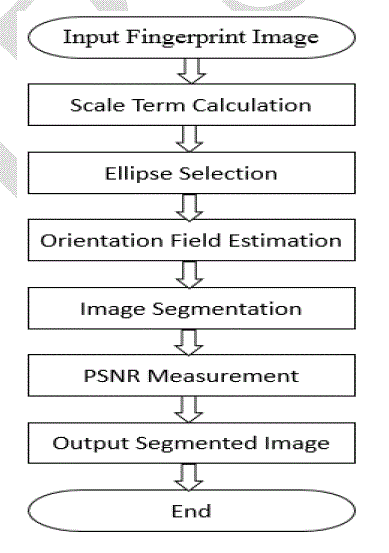 |
| When λ is very small (e.g., λ= 0.10), u captures the inhomogeneous illumination in the background while most fine structures are kept in v. When λ = 0.30, large-scale objects are separated from structures of smaller scales (characters). As λ continues to increase, only small-scale structures (fingerprint and noise) are left in ‘v’ and the major content of ‘f’ appears in ‘u’. |
| In the next phase ellipse is incorporated as a shape model for segmentation, which is used for determining the directional term. Orientation field ÃâÃÂ(x) is then estimated as given in [3]. The textures along the direction ÃâÃÂ(x) are fully captured by v, leaving textures of the remaining orientations in u. The orientation vector Ãâàcontrols the signal captured in the texture output v. By tuning Ãâàto a specific direction, we are mainly interested in minimizing the total variation of u along that direction, while allowing the existence of total variation of u along other directions. As a result, textures along the corresponding direction will be fully captured by v and textures of other directions will be weakened in v. In particular, textures along the orthogonal direction of Ãâàwill be totally blocked from v. Figure 3, illustrate the impact of Ãâàon the output of ‘v’. |
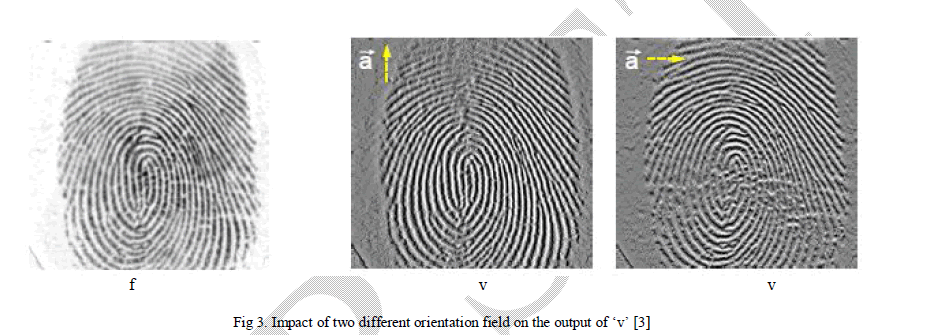 |
| Image is then segmented, including weight and orientation term, by solving the equations (1) and (2) of decomposition. Peak Signal to Noise ratio is measured for the segmented image as: |
 |
IV. EXPERIMENTAL RESULTS |
| In this section, we evaluate the proposed Adaptive and Orientation algorithm by couple of case studies. Two fingerprint images are consider in case studies and results are discussed under performance, parameter analysis and conclusion. Images for the case studies are collected from the web data. |
4.1 Case Study 1: |
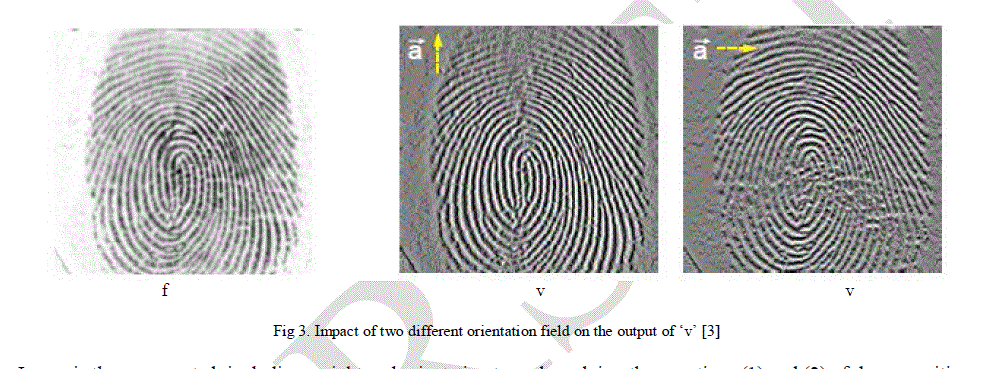 |
| 4.1.1. Performance: |
| In this case study, input image taken is shown in fig 4(a), which when processed results in an image as shown in fig 4(b). The output image is obtained at alpha (ellipse for segmentation) equals 10, resulting in PSNR of 78.3443 dB. The distribution of two features i.e. mean and variance, which are effective in the segmentation of fingerprint image is evaluated in fig. 5(a) and fig. 5(b) respectively. |
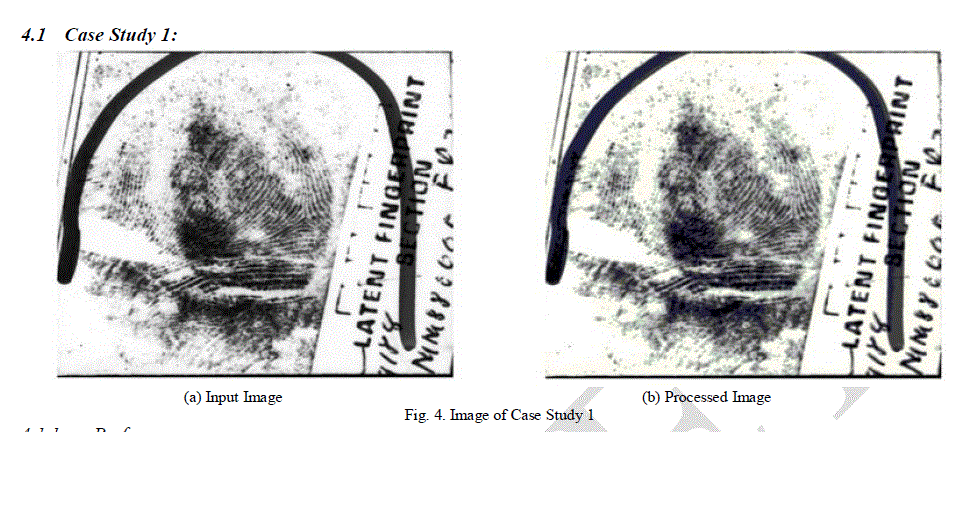 |
| 4.1.2. Parameter Analysis: |
| Figure 6 shows the effect of alpha (ellipse for segmentation) on the processed image and their respective PSNR value. The highest PSNR is obtained for alpha equals 10 which is 78.3443 dB, implies that it is the best segmentation result of case study 1. |
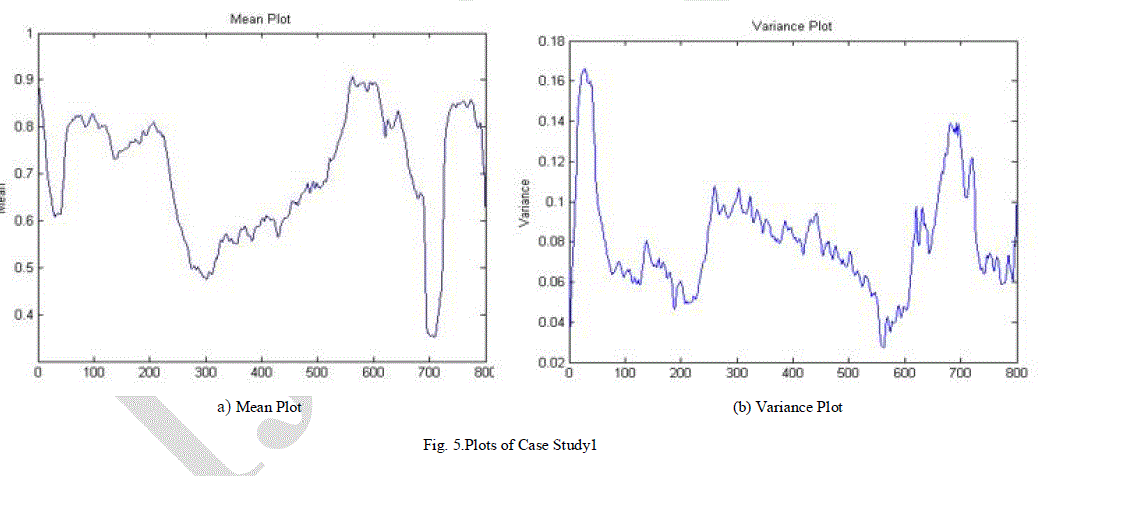 |
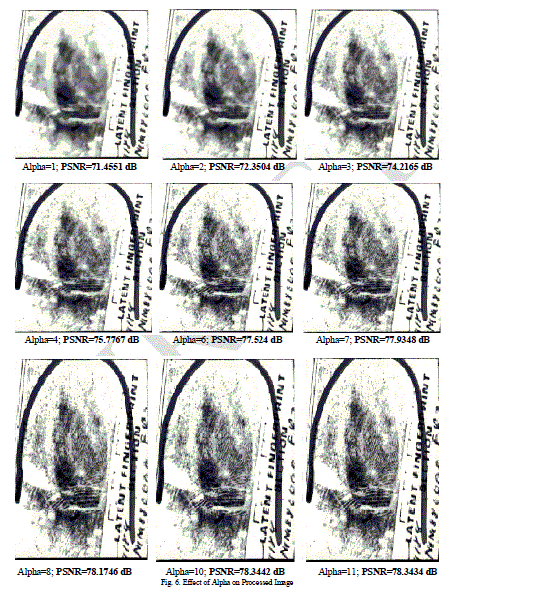 |
| 4.2.2 Parameter Analysis: |
| Figure 9 shows the effect of alpha (ellipse for segmentation) on the processed image and their respective PSNR value. The highest PSNR is obtained at alpha equals 4 which is 74.1238 dB, implies that it is the best segmentation result for case study 2. |
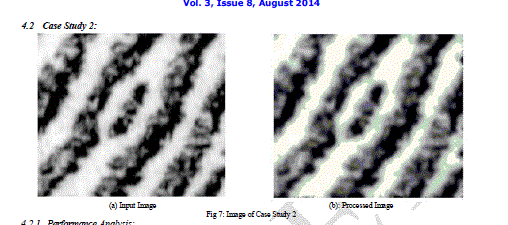 |
4.3 Comparison: |
| In this section, the proposed Adaptive and Orientation algorithm is compared with the existing Adaptive Total Variation (ATV) algorithm and Directional Total Variation (DTV) algorithm. Table 1 compares the PSNR and RMSE value obtained from Adaptive Total Variation (ATV) algorithm [4], Directional Total Variation (DTV) algorithm [3] and the proposed algorithm in this work for the two cases studied. Table 1 shows that the result obtained from the proposed algorithm is more accurate as compared to the other two existing algorithms. |
 |
V. CONCLUSION |
| The goal of this work is to achieve accurate segmentation, which is an essential step towards achieving automatic latent identification. In this paper, the Adaptive and Orientation algorithm as an image decomposition scheme is proposed and implemented, that facilitates effective fingerprint segmentation. Experimental results and comparison with individual existing ATV and DTV algorithm concludes that combined proposed algorithm is quite efficient and can be applied practically. |
References |
|